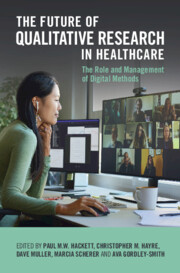Book contents
- The Future of Qualitative Research in Healthcare
- The Future of Qualitative Research in Healthcare
- Copyright page
- Dedication
- Contents
- Figures
- Tables
- Contributors
- Acknowledgements
- Chapter 1 Introduction to Digital Platforms and Digital Research Approaches, Encryption, Cybersecurity and Bandwidth
- Chapter 2 Doing Digital Qualitative Research
- Chapter 3 Using Video Diaries for Remote Observational Research
- Chapter 4 (In)Equitable Shifts
- Chapter 5 “To Be or Not to Be?” Qualitative Research upon and during a Pandemic Outbreak
- Chapter 6 Adopting Digital Methods
- Chapter 7 Lessons Learned Conducting Online Qualitative Interviews during Covid-19
- Chapter 8 Virtual Interviewing in the Age of Covid-19
- Chapter 9 Minimizing the Impact Technology Has on Interviewer–Interviewee Rapport
- Chapter 10 Participatory and Invasive Online Worlds
- Chapter 11 Using Online Survey Tools to Improve Access to International Experts
- Chapter 12 Refining Interview Protocols for Online Interviews on the Employment of Persons with Down Syndrome
- Chapter 13 Technology-Aided Programs to Support Leisure, Communication, and Daily Activities in People with Intellectual and Multiple Disabilities
- Chapter 14 Virtual Qualitative Data Collection
- Afterword
- Index
- References
Chapter 13 - Technology-Aided Programs to Support Leisure, Communication, and Daily Activities in People with Intellectual and Multiple Disabilities
Published online by Cambridge University Press: 14 November 2024
- The Future of Qualitative Research in Healthcare
- The Future of Qualitative Research in Healthcare
- Copyright page
- Dedication
- Contents
- Figures
- Tables
- Contributors
- Acknowledgements
- Chapter 1 Introduction to Digital Platforms and Digital Research Approaches, Encryption, Cybersecurity and Bandwidth
- Chapter 2 Doing Digital Qualitative Research
- Chapter 3 Using Video Diaries for Remote Observational Research
- Chapter 4 (In)Equitable Shifts
- Chapter 5 “To Be or Not to Be?” Qualitative Research upon and during a Pandemic Outbreak
- Chapter 6 Adopting Digital Methods
- Chapter 7 Lessons Learned Conducting Online Qualitative Interviews during Covid-19
- Chapter 8 Virtual Interviewing in the Age of Covid-19
- Chapter 9 Minimizing the Impact Technology Has on Interviewer–Interviewee Rapport
- Chapter 10 Participatory and Invasive Online Worlds
- Chapter 11 Using Online Survey Tools to Improve Access to International Experts
- Chapter 12 Refining Interview Protocols for Online Interviews on the Employment of Persons with Down Syndrome
- Chapter 13 Technology-Aided Programs to Support Leisure, Communication, and Daily Activities in People with Intellectual and Multiple Disabilities
- Chapter 14 Virtual Qualitative Data Collection
- Afterword
- Index
- References
Summary
Due to the COVID-19 pandemic, it has become essential for qualitative researchers to adopt online interviews for data collection. However, ensuring the validity of the interview protocol is no easy task, especially when the research involves people with intellectual disabilities. With these unique challenges, we attempted to validate the interview protocol to ensure the trustworthiness of the data. An online semi-structured interview protocol was developed and refined by integrating the Interview Protocol Refinement (IPR) Framework into a seven-step refinement process. A pilot test was conducted via video conference with five participants across five different groups. From the current pilot test, insights gained include (1) rephrasing the interview questions to assume casual conversation; (2) having a contingency plan in case of technical failure; (3) refining probes and follow-up questions; and (4) enhancing the reliability of proxy in interviewing person with Down syndrome. It is essential to develop a valid and reliable interview protocol to ensure a trustworthy qualitative finding. The process should be reflective and reiterative and should always be done in such a manner.
Keywords
- Type
- Chapter
- Information
- The Future of Qualitative Research in HealthcareThe Role and Management of Digital Methods, pp. 218 - 237Publisher: Cambridge University PressPrint publication year: 2024

